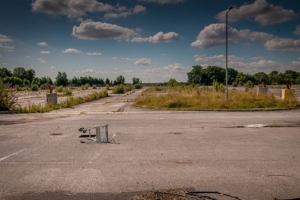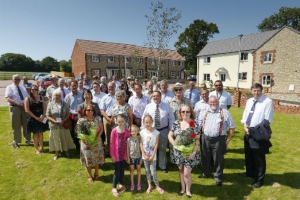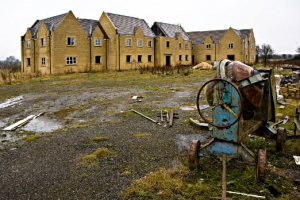Matt Thomson shares his ‘to do’ list for the revised national planning rules.
The Government keeps reminding us it has a ‘to do list’ for housing - we must:
- deliver the homes the nation needs
- protect the countryside
- and leave the environment in better condition than we found it in.
But sadly, like many of our own ‘to do lists’, it’s not managing to tick off any of those crucial elements. Next week, however, they might finally get to put a tick against an item on the Ministry of Housing, Communities and Local Government's (MHCLG) list if, as widely predicted, they publish the long-awaited redraft of the National Planning Policy Framework (NPPF) – the single document that sets out the government’s policies for how planning should work.
In the most basic sense, the NPPF’s job should be to encourage and enable ‘good development’ and restrict ‘bad development’. The underlying rhetoric from the Government must shift away from pushing homes to be built at whatever cost and towards an approach which balances the need for new developments with other needs and interests.
There is a housing crisis that must be addressed, but the solutions do not need to be at the expense of the countryside and its communities.
However, while the wording of the current NPPF can reasonably be interpreted as having that intention at heart, some of its wording is loose and is so open to interpretation - or conflicts with other government policy and statements - that these principles don’t fully coincide with reality as most people recognise it.
Are developments genuinely the ‘right homes’- that is, what communities need - rather than what sells fastest on the property market? In other words, are they in the right places, making good use of land? And in whose benefit are decisions made and who is in control of making them: communities, government or developers?
CPRE will be judging the new draft NPPF on how well it delivers on key countryside issues. We’ve helpfully created our own ‘to do’ list for the NPPF itself:
- Deliver the homes the nation needs rather than just follow market demand - focusing on increasing affordable housing provision and reforming the viability system stacked in developers’ favour.
- Maintain Green Belt policy and the protection of our National Parks and AONBs – respecting needed constraints on development.
- Embed a brownfield-first policy - prioritising the construction of over a million homes on sites already identified as suitable for housing development.
- Empower communities to manage the type and scale of development in their areas.
- Embed an understanding of what genuine sustainable development means and make sure that developments are permitted, and restricted, on this basis.
The NPPF is a critically important document that has a huge bearing on our countryside. It governs how communities are able to engage with proposals for development in their areas – to demand the development that they need, and to protect the open spaces, landscapes and places of cultural and environmental interest that they cherish and add such richness to their lives.
We must make sure the government gets it right. We’re really looking forward to ticking some items off our NPPF list and we’ll be poring over the draft over the coming months and letting you know how you can help hold government to account on its own promises.
Land-banking. A phrase that a few years ago would have been met with a quizzical, confused look is now on the lips of many housing commentators and policy-makers. It’s also shaping up to be the next big battle in the effort to tackle Britain’s housing crisis and prevent the unnecessary loss of countryside.
The government is waking up to the idea that the country’s biggest housebuilders are hoarding land. Secretary of State Sajid Javid wants Westminster to play a ‘more active, muscular role’ in tackling land-banking, and Tory grandee Sir Oliver Letwin MP is leading a review into the topic, to which I submitted evidence on behalf of the Campaign to Protect Rural England (CPRE).
So far, it has been Britain’s volume housing developers that have proved the most ‘muscular’. As reported in the FT last month, we’ve compiled evidence that shows the UK’s ten biggest housebuilders have increased the number of plots with planning permission they hold by a fifth in the past ten years, by two-fifths since 1998. Meanwhile, the number of homes completed each year has fallen by 13%. Alongside this, industry profits have skyrocketed, and the loss of our countryside accelerated.
This represents the tip of the iceberg; these figures only show plots with planning permission – we know that the developers hold wider, ‘strategic’ banks of land that do not yet have planning permission, the size of which is difficult to establish.

Developers maintain that they need a pipeline of land to maintain their profitability and ride out market volatility. This is true to some extent, but they restrict this pipeline at will, drip-feeding homes into the market at a pace that best serves their profits. Their swelling holdings are exacerbating the crisis of supply and affordability that has seen millennials pushed increasingly far away from owning their own home.
The hoarding of land also has a pernicious effect on our countryside. The dominance of the biggest developers means the market is increasingly geared towards the types of development they want, not what communities need. They are free to cherry-pick land that will make them the most proft - large tracts of undeveloped land carved out of the beautiful patchwork of English countryside we know and love.
This land is cheapest for them to develop, and allows them to focus on building sprawling estates of large houses at the expense of smaller, more affordable homes: 26% of all new houses and flats were three-bed in 2007; 19% were four-bed or more. By 2015 they were 34% and 29% respectively.
Local authorities, housing associations and other smaller builders are often prepared to build more quickly, are better placed to provide affordable housing, or redevelop existing brownfield sites rather than our green spaces, and they need to play a greater role. But, they are being squeezed out as the biggest builders consolidate their grip on the market; the volume builders now have 59% market share, up from 31% in 2007.
This is taking place in the context of the government’s drive to relax planning rules and release more of our countryside for development, and constant calls from developers to relax the rules further. However, despite this relaxation, the supply of housing has not kept pace with the number of planning permissions granted, demonstrating that the planning system is not a barrier to tackling the housing crisis – the biggest housebuilders are.
We really shouldn’t be surprised - the largest developers are FTSE250 companies that exist to maximise returns for their shareholders. But there are two key reasons we cannot rely on the biggest housebuilders to tackle the housing crisis or safeguard our great green outdoors:
- These developers are unlikely, under current planning policies and regulations, to boost housing supply to the level that ministers want and the public needs. This is unless action is taken to make them more responsive to social need, and level the playing field to allow local authorities and smaller players to regain the ground they have lost.
- Without reforms to the planning system to increase build out rates and reduce the pressure to release more land for development, the threat to our treasured landscapes will only increase.
We need action. We need stronger powers for local authorities to compel builders to build out sites with planning permission. We need strong ‘use it or lose it’ measures for large housebuilding schemes, with exemptions that incentivise a role for councils and small or medium-sized builders, and for building affordable housing first.
The Government should also explore reforms that make it easier to channel the rising values of land given permission for housing, towards funding infrastructure to serve that development – schools, healthcare and public transport.
These reforms will help to combat the increasingly distorting effects of land hoarding on the housing market - and our countryside.
 There will be much to welcome in this month’s Housing White Paper. We expect a big emphasis on brownfield development and more support to enable local authority planning departments to do their job. Best of all, the White Paper looks set to address the main cause of the housing shortage: over-dependence on a small number of big companies to deliver the new homes the country needs.
There will be much to welcome in this month’s Housing White Paper. We expect a big emphasis on brownfield development and more support to enable local authority planning departments to do their job. Best of all, the White Paper looks set to address the main cause of the housing shortage: over-dependence on a small number of big companies to deliver the new homes the country needs.
For too long the state’s responsibility for decent housing has been outsourced to private developers who have neither the will nor capacity to build on the scale needed. Now at last Ministers seem willing to tackle this market failure, for instance by helping small builders and promoting custom build and ‘modern methods of construction’.
No quick fix
But we should not expect to see any quick increase in output. The Government is stuck with a policy of setting housing targets and making more land available in the hope that developers increase their output. This approach has failed for years and it will continue to fail. Under the current system, councils are pressured to set unachievably high housing targets and to demonstrate that they have a five-year supply of land to meet them.
Targets are missed because developers do not use the planning permissions they have; the local authority has to release more land; developers cherry pick the best sites, often in the Green Belt or other countryside, but build so slowly that the local authority is unable to demonstrate that it has a five year land supply; this then leaves the door open for predatory firms to put in speculative applications in the countryside on the grounds that the council does not have a valid plan in place.
The Government has published a 10-point plan that will be put into action to increase productivity growth in England’s rural areas.
In response to today's announcement, John Rowley, planning officer at the Campaign to Protect Rural England (CPRE), said:
"CPRE welcomes the Government’s recognition that rural areas can play an important role in generating economic growth, and that they need good quality housing and services in order to achieve this.
"We are concerned, however, that the Rural Productivity Plan suggests that growth and development in the countryside will override the protections of our beautiful English countryside. The proportion of development on greenfield sites is currently at its highest since 1999 and the proposals for further planning deregulation risk putting villages and landscapes at additional risk of inappropriate developments.
"We recognise that providing the right houses in the right places that meet local need is a vital part of ensuring that our villages remain vibrant and sustainable. However, the proposals set out in the Rural Productivity Plan risk alienating local communities and reducing the amount of affordable housing in rural areas. The Government’s suggestion that young families will be able to afford houses at even 20% discount will not ring true in many low-waged rural economies.
Rural housing should be provided to meet identified local need. Without a recognition of the distinctive needs of rural areas, the Government’s drive to encourage Starter Homes will significantly undermine this principle and could turn villages against new development as Starter Homes will be available to anyone and it’s likely that commuters will be able to outbid local families. And the 20% discount which the purchaser of the property will benefit from will not remain in perpetuity. The result will be that there is no incentive for local people to support this type of development. The proposed extension to the Right to Buy to include housing association properties will also add to this problem. Rural areas should be exempted from the extension to Right to Buy in order to protect the already dwindling stock of affordable homes available."
CPRE argues that rural areas should be treated as a special case to protect and provide affordable housing
It has been reported that a farmer in Sussex has rebuffed an offer for his land 100 times its current value – partly based on a desire to protect the countryside for future generations. CPRE welcomes such commitment to the countryside, but also argues that this case once again illustrates the failures of our planning system in encouraging aggressive, speculative development. Graeme Willis, senior rural affairs campaigner at the Campaign to Protect Rural England (CPRE), comments:
“This seems exceptional on a number of levels. We recently heard of a case where an offer of 20 times the current value of land was turned down, so 100 times is very significant. It is also extremely admirable that the farmer in question has reportedly rebuffed the offer for quality of life and community reasons. He has sought to preserve the countryside for the generations after his – and has placed these considerations above financial incentives.
“It is invidious that so many landowners are put in this position by highly speculative land acquisition – especially where there is huge community opposition and no planning permission. The current developer-led planning system has significantly increased the regularity and pressure of speculative development – which is both divisive and distressing for communities. In its place, we need a plan-led system where the focus is on land that people want to see developed – like the brownfield sites around the country that can provide the space for one million new homes.
“Finally, the value of farmland must be emphasised more in the debates about new housing. Unless we have a better way of factoring in the production value of land, rather than always seeing it trumped by development value, then we will continue to lose vital farmland that feeds our rural and urban areas. Climate change and global pressures on land necessitate the preservation of our best farmland for food production – not unwanted and unsustainable housing developments.”
CPRE’s Targeting the countryside report shows that when you look at major housing development, particularly on greenfield sites, 72 per cent of local decisions are overturned at appeal where the council cannot demonstrate a five year supply of housing land. It also shows that even where a council can demonstrate five year supply, one in six local decisions are overturned – something that should never happen.
In The Mirror today, CPRE head of planning Matt Thomson was quoted on the NPPF’s presumption in favour of development, and how the planning legislation encourages speculative development. Matt’s full view is:
“Leading politicians repeatedly say that we should protect the countryside, and that the legislation is there for us to do so. Yet even areas like Green Belts and designated landscapes are threatened under appeal because cash strapped councils cannot afford the legal costs of fighting developers. Planning decisions are only ‘local’ if they are made by local people in line with their needs and aspirations, but too often decisions appear to be made on basis of risk management rather than good planning.
“While it may be true to argue that many elements of current policy – including five year housing land supply – were introduced before the NPPF, the NPPF sets an agenda where growth outweighs other considerations.
“The NPPF’s ‘presumption in favour of sustainable development’ encourages speculative developers to challenge community aspirations rather than to deliver those aspirations. It gives them reason to expect that random and unsustainable proposals will be approved. And it disempowers and demoralises both councils and communities, encouraging them to submit to the developers’ plans rather than face the cost and trouble of defending communities’ rights.”
A new powerful alliance of Campaign to Protect Rural England (CPRE), Civic Voice and the National Association of Local Councils (NALC), today (14 March) called on all political parties to make a firm manifesto commitment to introduce a “community right of appeal” into the planning system.
The alliance believes that all political parties should support local ambitions by introducing a limited community right of appeal in areas where a development is non-compliant with a neighbourhood plan or local plan. Currently parish councils and other community groups have the power to produce neighbourhood plans, but no scope to stop developers overriding this by putting in speculative planning applications for approval by the district council. Budget cuts within local authorities mean that they are under increasing pressure to allow large developments, even when these are not in line with the community's aspirations for the future of its area.
The call was made today at the Liberal Democrat Spring Conference where the three organisations have joined together with Liberal Democrat MP for Cheltenham Martin Horwood a MP to hold a debate on the benefits of such a right.
Martin Horwood said: "The introduction of a Community Right of Appeal could be triggered when a high threshold of community opposition was reached. Grounds for appeal could include insufficient infrastructure, non-compliance with government guidance and non-compliance with a local neighbourhood plan. We can all think of examples across Cheltenham when this right could have been used and there must be thousands across the country."
CPRE Chief Executive Shaun Spiers said: "The planning system needs to be rebalanced to give communities the right to stand up to bullying developers and appeal against planning decisions which ignore local or neighbourhood plans. The grounds on which developers can appeal should be restricted and a limited community right of appeal introduced. The vast majority of planning applications would be unaffected by such measures, but they would provide important safeguards to ensure communities can resist unsustainable development proposals."
Freddie Gick, Chair of Civic Voice said: “At present, the only recourse for the public against poor planning decisions is judicial review. A right of appeal would give local people a real opportunity to have a say and would rebalance the planning system and help deliver true localism.”
NALC Chairman, Councillor Ken Browse said: “The voice of local people through the local (town and parish) councils should always be at the heart of planning. To some extent this is being achieved through the statutory neighbourhood plan. But communities via local councils feel that their planning demands are being ignored and there is still the potential for developers to try and ride roughshod against the neighbourhood plan. So a ‘right of appeal’ would stop this planning injustice”.
The three organisations have published their own individual manifestos and are each calling for a community right of appeal within them.
Notes for Editors
1. The National Association of Local Councils (NALC) is the nationally recognised membership body representing the interests of 9,000 local councils. They have 80,000 local councillors in England.NALC’s manifesto can be found at: http://www.nalc.gov.uk/our-work/the-manifesto-campaign. For further information please contact Alan Jones, 020 7290 0304 or This email address is being protected from spambots. You need JavaScript enabled to view it.
2. Civic Voice is the national charity for the civic movement in England. We make places more attractive, enjoyable and distinctive. We promote civic pride. Civice Voice’s manifesto can be found at: http://www.civicvoice.org.uk/manifesto For more information please contact Ian Harvey, 07877096968 or This email address is being protected from spambots. You need JavaScript enabled to view it.
3. The Campaign to Protect Rural England (CPRE) fights for a better future for the English countryside. We work locally and nationally to protect, shape and enhance a beautiful, thriving countryside for everyone to value and enjoy. Our members are united in their love for England’s landscapes and rural communities, and stand up for the countryside, so it can continue to sustain, enchant and inspire future generations. Founded in 1926, President: Sir Andrew Motion, Patron: Her Majesty The Queen. CPRE’s manifesto can be found at: http://www.cpre.org.uk/manifesto For further information, please contact Benjamin Halfpenny on 020 7981 2819 or This email address is being protected from spambots. You need JavaScript enabled to view it.









